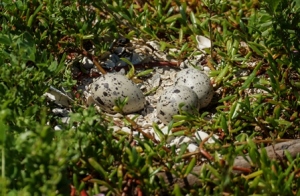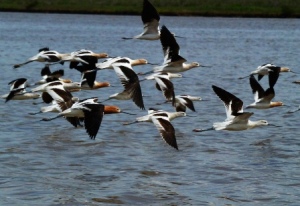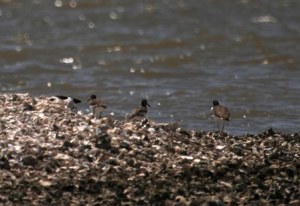By Susan Heath
We finally had some good weather! Monday (the 23rd) was a beautiful day with bright blue skies, lots of sun, and only a slight wind. I even had to put on sunscreen. Ah, Texas in spring! Love it. I was joined by Alan Wilde who is quickly becoming my number one assistant and Dianne Forthman, another Galveston Bay Area Master Naturalist, for our survey in West Galveston Bay. We had a very long day but it was worth it. We found 13 new nests and three of the previous nests had hatched and had chicks! J6 & P4 had one chick that looked about a week old. JN & JE had two chicks that looked only a few days old and L2 & unbanded had small chicks too but we couldn’t tell how many because one of the adults was brooding them and we didn’t want to get too close and disturb them. I suspect another nest was in the process of hatching because one adult was on the nest but the other one was nearby appearing to keep watch and it was time for the nest to hatch. We will see the next time we head out there.
Unfortunately five nests failed and we weren’t able to figure out what happened on any of them. Three of them were on the same island which is very close to Galveston but that island has been one of the most productive ones in the past so I’m not sure what’s going on there. It would be easy for a mammalian predator to get to it, but all the nests appeared to have been incubated to hatching and that’s when things went wrong. I just don’t know what. One of the other nests that failed was on a large island and when we arrived there on Monday to check, the whole area was covered with American White Pelicans so I suspect that one got trampled. The white pelicans like to roost on the island edges right where the oystercatchers nest unfortunately. That pair will just have to wait to try again until these big guys head north. The fifth one that failed was in an area that is prone to coyote predation and I suspect that’s what happened to it.
We managed to catch one adult on the nest. All the color bands I had started with E and Alan picked ET for this guy. I’m pretty sure it was the male. Here’s a photo of Dianne holding ET.
On Wednesday I went out to Bastrop and Drum Bays with volunteers Pete and Peggy Romfh. We had to use a different boat ramp than normal so we the survey in reverse. In Drum Bay, we found that K0 had either moved to a neighboring territory or expanded his own to include the unattended neighboring territory. Last year he was paired with AR but this year he is paired with an unbanded bird so AR either left to find a mate with a better territory or something happened to her. Anyway, K0 and mate had a nice scrape prepared but no eggs yet. K1 & 30 had a one egg nest, our first nest in Drum Bay this year. I’m sure they were just getting started and will lay more eggs. None of the other pairs there had nests but they were all hanging around. There was a Peregrine Falcon roosting on JT’s nesting island so that might have something to do with why that pair hasn’t laid eggs yet! Up in Bastrop Bay we found that J8 & UR had a one egg nest too. They weren’t incubating it yet and we wouldn’t have found it except that there was a debilitated Herring Gull on the island so we stopped to see what was wrong with it. It appeared to be afflicted with botulism, a condition whose first symptom is the inability to walk. While I was checking out the gull, I noticed the nest and then I saw a Laughing Gull in the same condition as the Herring Gull. Sheesh. They must have both eaten the same thing. We put them both on the boat and took them with us so I could bring them to a rehabber. We found the unbanded pair on the next island had a three egg nest so we trapped the incubating adult. I let Peggy pick the color bands and she decided on EJ. I’m pretty sure EJ was the male as he was even smaller than the one we banded on Monday.
On our way back to the boat ramp we spotted a flock of American Avocets and just had to stop for some photos. One of the benefits of being out in a boat!
Our local rehabber Dana Simon met us on our way taking the boat back to the refuge and took the gulls. She said she thought they had about a 50% chance of making it. When last I checked with her they were both doing fine though.
On Thursday I was supposed to go to East Matagorda Bay but the weather was not conducive to being on a boat so we had to reschedule for Monday (30th). My volunteers at the Texas City Prairie Preserve reported that two of their nests had failed but there were three new nests there and one had hatched. Unfortunately they found the remains of a campfire about 5 ft from where one of the nests had been, a sure sign that human disturbance played a part in that nest failure. What a shame. Here’s a photo of the evidence.
So on Monday, my good friend and great volunteer Charlie Brower went with me and we had a great day. The pair that we discovered last time with three chicks (M4 & her unbanded mate) still had three chicks! Here’s a poor photo of two of them.
Two of the other nests in that area had hatched too. Both had very small chicks that looked only a day or so old. One had three and one had two. Here’s a photo of the one with three. They were hiding along the water’s edge so you have to look hard to see them. We snapped a few photos and then got the heck out of there. I don’t usually go on islands when there are small chicks but we actually thought this nest had failed and were trying to determine why when we stumbled on the chicks. We found three new nests total and trapped two more adults. Charlie picked the color bands. I had only bands that started with E with me still so he picked EL for the first one and then started calling it El Oystercatcher and saying that it was Spanish! For the second one he picked ER and said that was short for Ever Ready. Apparently he had a friend when he was young who went by his initials which were ER and his friends called him Ever Ready. If you hang around Charlie much you hear all sorts of tales. I never know which are true and which are not but they are all entertaining! Here’s a photo of Charlie with Ever Ready.
Here’s another bit of exciting news. I got word from a Louisiana biologist that she spotted two of our 2014 chicks there! There has only been one of our banded oystercatchers spotted outside Texas. That one was in Louisiana as well and was also a young bird. I have suspected for a long time that at least some of the young birds are dispersing to other areas and this adds a little proof to that theory.
Current Stats: 31 nests being incubated, 7 failed nests, 7 nests with unfledged chicks, 0 chicks fledged
Here’s a big shout out to our additional oystercatcher adoptees: Pete and Peggy Romfh (again!) and Lynn Wright. THANK YOU!
You can still adopt a single adult, a pair of adults, or a chick on our website here and of course if you just want to donate you can do that through our Just Give portal. In a couple weeks we should have some chicks ready for adoption!
Filed under: Birding
![]()









